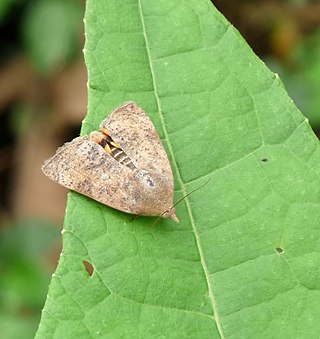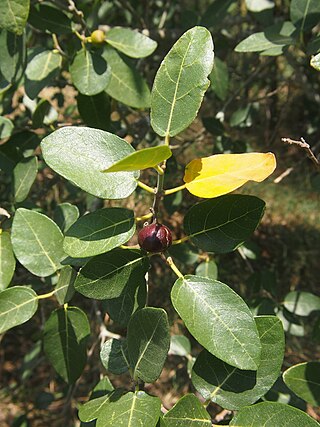
Caterpillars are the larval stage of members of the order Lepidoptera.

Butterflies are winged insects from the lepidopteran suborder Rhopalocera, characterized by large, often brightly coloured wings that often fold together when at rest, and a conspicuous, fluttering flight. The group comprises the superfamilies Hedyloidea and Papilionoidea. The oldest butterfly fossils have been dated to the Paleocene, about 56 million years ago, though they likely originated in the Late Cretaceous, about 101 million years ago.

Lepidoptera or lepidopterans is an order of winged insects that includes butterflies and moths. About 180,000 species of the Lepidoptera have been described, representing 10% of the total described species of living organisms, making it the second largest insect order with 126 families and 46 superfamilies, and one of the most widespread and widely recognizable insect orders in the world.

The butterfly bend is a knot used to join the ends of two ropes together. It is the analogous bend form of the butterfly loop, in that it is the butterfly loop with the loop cut. The observation that the butterfly loop is secure enough to isolate a worn or damaged section of rope within the loop indicated that the bend form of the knot would be similarly secure.

Swallowtail butterflies are large, colorful butterflies in the family Papilionidae, and include over 550 species. Though the majority are tropical, members of the family inhabit every continent except Antarctica. The family includes the largest butterflies in the world, the birdwing butterflies of the genus Ornithoptera.

Jacob Hübner was a German entomologist. He was the author of Sammlung Europäischer Schmetterlinge (1796–1805), a founding work of entomology.

Schreckensteinioidea is a superfamily in the insect order Lepidoptera containing a single family, Schreckensteiniidae, or "bristle-legged moths", because of the stout spines on the hindlegs. The superfamily and family were both described by Thomas Bainbrigge Fletcher in 1929. The relationships of this family within the group apoditrysia are currently uncertain. One of the species, the blackberry skeletoniser, is widespread and common across Europe and has been introduced as a biological control to Hawaii, whilst three species of Corsocasis occur in South East Asia.

Eriocraniidae is a family of moths restricted to the Holarctic region, with six extant genera. These small, metallic moths are usually day-flying, emerging fairly early in the northern temperate spring. They have a proboscis with which they drink water or sap. The larvae are leaf miners on Fagales, principally the trees birch (Betula) and oak (Quercus), but a few on Salicales and Rosales.

Colias hyale, the pale clouded yellow, is a butterfly of the family Pieridae, which is found in most of Europe and large parts of the Palearctic. It is a rare migrant to the British Isles and Scandinavia. The adult wingspan is 52–62 millimetres (2.0–2.4 in).

Leptidea reali, the Réal's wood white, is a butterfly of the family Pieridae.

Hyblaeidae are the "teak moths", a family of insects in the Lepidopteran order. The two genera with about 18 species make up one of the two families of the Hyblaeoidea superfamily, which in the past has been included in the Pyraloidea. Recent phylogenetic studies find varying relationships of Hyblaeoidea among Ditrysian Lepidoptera: Mutanen et al. (2010) find the superfamily to group either with Pyraloidea, or – more often – with Thyridoidea or butterflies. The results of Wahlberg et al. (2013) and Heikilä et al. (2015) indicate a sister-group relationship with Pyraloidea.

Heteroneura is a natural group in the insect order Lepidoptera that comprises over 99% of all butterflies and moths. This is the sister group of the infraorder Exoporia, and is characterised by wing venation which is not similar or homoneurous in both pairs of wings. Though basal groups within the Heteroneura cannot be identified with much confidence, one major subgroup is the leaf-mining Nepticuloidea. Species in this subgroup include some of the smallest lepidopterans identified.

Cimeliidae, the gold moths, is a family of moths that is now placed in the macroheteroceran superfamily Drepanoidea, although previously placed in its own superfamily. Uniquely, they have a pair of pocket-like organs on the seventh abdominal spiracle of the adult moth which are only possibly sound receptive organs. They are quite large and brightly coloured moths that occur in southern Europe and feed on species of Euphorbia. Sometimes they are attracted to light. The family was first described by Pierre Chrétien in 1916.

Artanish is a village in the Shoghakat Municipality of the Gegharkunik Province of Armenia. The village was populated by Azerbaijanis before the exodus of Azerbaijanis from Armenia after the outbreak of the Nagorno-Karabakh conflict. In 1988-1989 Armenian refugees from Azerbaijan settled in the village. On a hill just to the west are the ruins of cyclopean fortresses, and nearby is a church and a cemetery.

Ficus opposita is one of several fig species commonly known as sandpaper figs. It is native to the Northern Territory and Queensland in Australia.Other common names include sweet sandpaper fig, sweet fig and the ambiguous "figwood" and "watery fig".

The Golden Butterfly is a 1926 Austrian-German silent drama film directed by Michael Curtiz, and starring Hermann Leffler, Lili Damita, and Nils Asther. It was based on the 1915 short story "The Making of Mac's" by British author P. G. Wodehouse. The film was released in the United Kingdom as The Golden Butterfly, in a form shortened to 5 reels, and had a limited release in the US under the title The Road to Happiness.
Lachnocnema durbani, the D'Urban's woolly legs, is a butterfly of the family Lycaenidae. It is found from Cape Point and KwaZulu-Natal to Mozambique to Kenya, Malawi, Tanzania, and Uganda. The habitat consists of grassy areas in savanna.

Battus lycidas is a species of butterfly in the family Papilionidae native to the Neotropical realm. It is commonly known as Cramer's swallowtail, the Lycidas swallowtail, and the yellow-trailed swallowtail.

Micropterigoidea is the superfamily of "mandibulate archaic moths", all placed in the single family Micropterigidae, containing currently about twenty living genera. They are considered the most primitive extant lineage of lepidoptera, and the sole superfamily in the suborder Zeugloptera. The name comes from the Greek for mikros, little and pterux, a wing. Unique among the Lepidoptera, these moths have chewing mouthparts rather than a proboscis, and are seen feeding, often in large aggregations, on the pollen of the flowers of many herbaceous plants, shrubs and trees. The fossil record of the group goes back to the middle-late Jurassic with the earliest known species being Auliepterix from the Karabastau Formation in Kazakhstan.
Karataunia is an extinct genus of butterfly from the Upper Jurassic of Karatau, Kazakhstan. It contains only one species, Karataunia lapidaria. Its family and superfamily placement is uncertain.

















